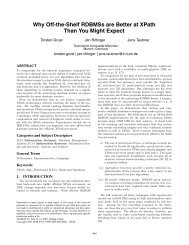Chapter 10 The Traveling Salesman Problem
Chapter 10 The Traveling Salesman Problem
Chapter 10 The Traveling Salesman Problem
You also want an ePaper? Increase the reach of your titles
YUMPU automatically turns print PDFs into web optimized ePapers that Google loves.
Assume a tour on the graph. Let it be x1 x2 xn x1 .<br />
We assume a directed cycle T’ which is constructed by orienting all the edges on the tour. For a<br />
backward arc in the cycle e(j,i), we define its length as q(e) = j-i.<br />
We express the sum of the lengths of the backward arcs in the cycle as q(T’).<br />
Assume the most expensive non-pyramidal tour T. Let Cmax- be the cost of this tour.<br />
We have to show that<br />
Cmax < C nn,<br />
<strong>10</strong>.28<br />
as there are 2 n-3 pyramidal tours.<br />
It is true that q(T’) ≥ n for every T’.<br />
Assume a non pyramidal tour H of cost Cmax and ei = (i,j) be an arc of H’.<br />
If e1 is forward then c (e1) ≤ iN +2.<br />
If e1 is backward then c(e1) ≤ jN +2 – q(ei)N.<br />
Thus we can write:<br />
n<br />
Cmax ≤∑ ( iN + 2)<br />
- q(H’)N ≤ ∑ +2n <strong>10</strong>.29<br />
− n 1<br />
iN<br />
i=<br />
1<br />
As q(H’) ≥ n. From the preceding equations, we conclude that indeed<br />
Thus, the theorem is proven.<br />
i=<br />
1<br />
Cmax < C nn<br />
<strong>10</strong>.2.5 <strong>The</strong> branch and bound algorithm and its complexity<br />
<strong>The</strong> branch and bound algorithm converts the asymmetric traveling salesman problem into an<br />
assignment problem. Consider a graph V that contains all the cities. Consider Π being the set of<br />
all the permutations of the cities, thus covering all possible solutions. Consider a permutation of<br />
this set π∈Π in which each city is assigned a successor, say i,for the πi city. So a tour might be (1,<br />
π(1), π(π(1)),…,1). If the number of the cities in the tour is n then the permutation is called a<br />
cyclic permutation. <strong>The</strong> assignment problem tries to find such cyclic permutations and the<br />
asymmetric traveling salesman problem seeks such permutations but with the constraint that they<br />
have a minimal cost. <strong>The</strong> branch and bound algorithm firstly seeks a solution of the assignment<br />
problem. <strong>The</strong> cost to find a solution to the assignment problem for n cities is quite large and is<br />
asymptotically O(n 3 ).<br />
If this is a complete tour, then the algorithm has found the solution to the asymmetric traveling<br />
salesman problem too. If not, then the problem is divided in several sub-problems. Each of these<br />
sub-problems excludes some arcs of a sub-tour, thus excluding the sub-tour itself. <strong>The</strong> way the<br />
algorithm chooses which arc to delete is called branching rules. It is very important that there are<br />
no duplicate sub-problems generated so that the total number of the sub-problems is minimized.<br />
Carpaneto and Toth have proposed a rule that guarantees that the sub-problems are independent.<br />
<strong>The</strong>y consider the included arc set and select a minimum number of arcs that do not belong to that<br />
set. <strong>The</strong>y divide the problem as follows. Symbolize as E the excluded arc set and as I the included<br />
arc set. <strong>The</strong> I is to be decomposed. Let t arcs of the selected sub-tour x1x2 ...xn not to belong to I.<br />
<strong>The</strong> problem is divided into t children so that the jth child has Ej excluded arc set and Ij included<br />
arc set. We can now write:






